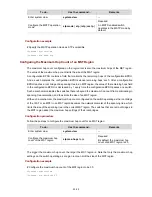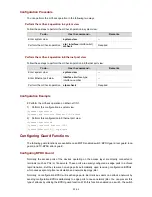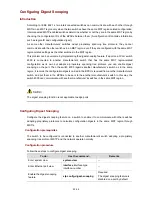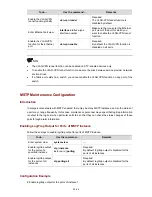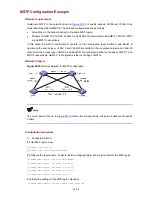
20-31
Rate
Operation mode
(half-/full-duplex)
802.1D-1998
IEEE 802.1t
Latency
standard
1,000 Mbps
Full-duplex
Aggregated link 2 ports
Aggregated link 3 ports
Aggregated link 4 ports
4
3
3
3
20,000
10,000
6,666
5,000
20
18
16
14
10 Gbps
Full-duplex
Aggregated link 2 ports
Aggregated link 3 ports
Aggregated link 4 ports
2
1
1
1
2,000
1,000
666
500
2
1
1
1
Normally, the path cost of a port operating in full-duplex mode is slightly less than that of the port
operating in half-duplex mode.
When calculating the path cost of an aggregated link, the 802.1D-1998 standard does not take the
number of the ports on the aggregated link into account, whereas the 802.1T standard does. The
following formula is used to calculate the path cost of an aggregated link:
Path cost = 200,000,000 / link transmission rate
Where, “link transmission rate” is the sum of the rates of all the unblocked ports on the aggregated link
measured in 100 Kbps.
Configure the path cost for specific ports
Follow these steps to configure the path cost for specified ports in system view:
To do...
Use the command...
Remarks
Enter system view
system-view
—
Configure the path cost for
specified ports
stp interface
interface-list
[
instance
instance-id
]
cost
cost
Required
An MSTP-enabled switch can
calculate path costs for all its
ports automatically.
Follow these steps to configure the path cost for a port in Ethernet port view:
To do...
Use the command...
Remarks
Enter system view
system-view
—
Enter Ethernet port view
interface
interface-type
interface-number
—
Configure the path cost for the
port
stp
[
instance
instance-id
]
cost
cost
Required
An MSTP-enabled switch can
calculate path costs for all its
ports automatically.
Changing the path cost of a port may change the role of the port and put it in state transition. Executing
the
stp cost
command with the
instance-id
argument being 0 sets the path cost on the CIST for the port.
Configuration example (A)
# Configure the path cost of Ethernet 1/0/1 in MSTI 1 to be 2,000.






